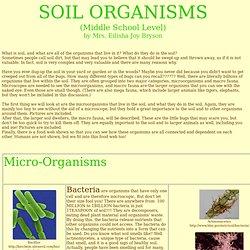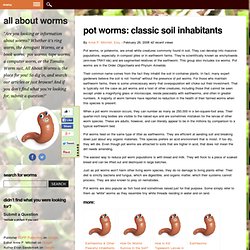

Enchytre. Untitled Document. Naissance de bébés lombrics. Soilcollege. SOIL ORGANISMS(College Level) by Mrs.

Eilisha Joy Bryson The soil is a complex system of organic and inorganic matter. It consists of various layers of this material, each varying in the amount of solid, gases, liquids, and organic matter. A general analysis of soil shows that about 40% are rocks and minerals, 25% gases, 25% liquid, and 10% organic matter. Perhaps the most important microorganisms in the soil ecosystem are bacteria. Bacteria are also responsible for decomposing other compounds as well. Other macro fauna include nematodes, mollusks, and arthropods. Soil organisms are not always beneficial. organisms that pose a threat to plants and microorganisms that aid the plants are viewed as pests. As is described above, the organisms in the soil contribute greatly to the wellness of the plants that grow from the soil.
Biology 501 Class Notes. Ingham, E. (2000). Jackson, R. and Raw, F. (1966). Krogh, D. (2005). Mackenzie, F. (2003). Soilmiddle. SOIL ORGANISMS(Middle School Level) by Mrs.

Eilisha Joy Bryson What is soil, and what are all of the organisms that live in it? What do they do in the soil? Sometimes people call soil dirt, but that may lead you to believe that it should be swept-up and thrown away, as if it is not valuable. In fact, soil is very complex and very valuable and there are many reasons why. Have you ever dug-up the soil in your yard or garden or in the woods? The first thing we will look at are the microorganisms that live in the soil, and what they do in the soil. Soil Food WebThe following diagram shows how all of the organisms that are discussed above are dependent on each other for survival.
All About » Pot Worms: Classic Soil Inhabitants. Pot worms, or potworms, are small white creatures commonly found in soil.

They can develop into massive populations, especially in compost piles or in earthworm farms. They’re scientifically known as enchytraeids (enn-kee-TRAY-ids) and are segmented relatives of the earthworm. This group also includes ice worms. Pot worms are in the Order Oligochaeta and Phylum Annelida. Their common name comes from the fact they inhabit the soil in container plants. When a pot worm invasion occurs, they can number as many as 250,000 in a ten-square-foot area. Disgusting thin clear worms - House Plants Forum. Pot Worms: Little White Worms in the Worm Composting Bin. Pot Worms Are Tiny White Worms that Are Part of the Decomposing Process in a Worm Bin.

Recently I read a post on the internet about someone being so excited to see so many baby worms in the worm bin. I am thinking that I never saw a huge group of baby redworms together. I see them here and there but not grouped together. So I think this person was actually looking at the little white worms called pot worms, also known as enchytraeids. They measure 1/4 to 1 inch long. Pot worms tend to congregate together under cantaloupe rind or bread or some other kind of food. There is a discussion of whether it is a good thing to have pot worms in your worm bin. My experience is that they dwell together with the red wigglers in balance and they are not a problem. Worms Eat My Garbage is a Great Book to Learn All About Worm Composting There is an excellent book that I highly recommend about worm composting: Worms Eat My Garbage: How to Set Up and Maintain a Worm Composting System by Mary Appelhof.
Untitled Document. OSU Nematode Testing Service.